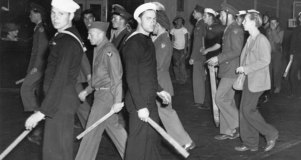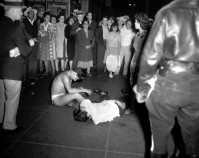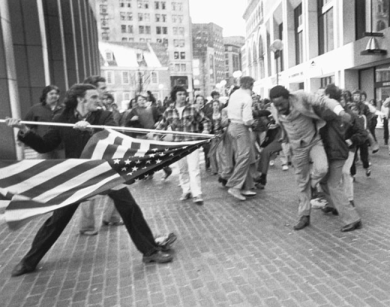Part One
Question: What’s the difference between ignorance and apathy?
Answer: I don’t know, and I don’t care!
We need to talk, and we need to listen to the voice of The Other. One of the most fundamental aspects of privilege – the privilege to ignore, the privilege to remain innocent in our minds – still retains its durability among far too many of us. We need to talk about how America established that privilege – in law – from the very beginning, indeed, from before the beginning. In other words, I’m talking about America’s long history of Affirmative Action for white people.
Other than abortion, no domestic issue has been as controversial and divisive over the past fifty years as affirmative action. Opportunistic politicians have used it to create a wedge between working class whites and blacks. 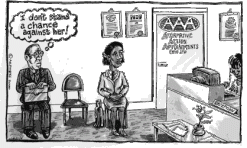 Well versed in the imagery of American myth, they have repeatedly posed the question (in soft terms, careful to not appear overtly racist) of whether it is just for hardworking people to be taxed so as to support people who are too lazy and irresponsible to better themselves. As I write in Chapter Seven of my book Madness at the Gates of the City: The Myth of American Innocence,
Well versed in the imagery of American myth, they have repeatedly posed the question (in soft terms, careful to not appear overtly racist) of whether it is just for hardworking people to be taxed so as to support people who are too lazy and irresponsible to better themselves. As I write in Chapter Seven of my book Madness at the Gates of the City: The Myth of American Innocence,
Reactionaries invoke (the myth of) equality by claiming that legal equality is sufficient and calling affirmative action “reverse discrimination” and ethnic liberals “reverse racists.” Some even argue that since prejudice no longer exists, minorities should require no assistance (which only encourages the sin of laziness). This false argument has potency because it contains some truth; since individuals have occasionally “pulled themselves up by their own bootstraps,” then conservatives claim that everyone should. If they can’t, says the myth, Puritan at its core, then failure is their own fault.
In doing so, these politicians, and many religious leaders, have duped three generations of misinformed whites into perceiving themselves as victims of people whom they once regarded as natural allies. And (when discuss the New Deal and the G. I. Bill) we should note that the demographic most opposed to taxes for welfare – those over the age of 65 – are themselves the beneficiaries of the greatest welfare programs in world history.
But this is hardly the first time this has happened. In Chapter Ten I write:
The narrative veils the issues of corporate welfare, financial corruption and deindustrialization and the fact that most white males vote Republican, partially because they fear affirmative action. Few admit the racial dimensions of the issue and the degree to which even poor whites have privilege. Actually, the generosity of state welfare reform varies according to demography: those with overwhelmingly white populations have stronger safety nets and impose softer sanctions.
So we need to learn how the federal government has instituted affirmative action for white people many times over the course of our history, and that this reality is a fundamental aspect of the Myth of American Innocence. Indeed, it began long before the creation of the federal government itself. For a much more detailed version of this timeline, see my essay “Who Is An American?”
We have to begin with the foundational factor, that a series of American Presidents and Supreme Court Justices, most of whom were themselves slaveholders, did nothing to change the condition of literally millions of black people (four million in 1860 alone) who were legally enslaved and deprived of almost any possibility of legal economic or personal improvement for 245 years. These were the people whose unpaid labor, brutal treatment and family separation were the foundations for the creation not only of most personal American fortunes, but as many academics argue, of the world-wide industrial revolution itself.
A just society would at least begin the conversation of how to compensate their descendants for the condition of entering civil 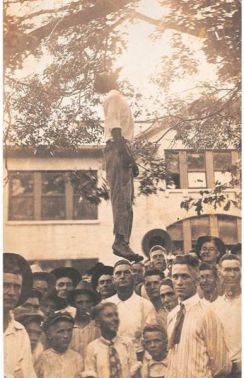 society as free people, but with none of the accumulated equity that generations of whites were already enjoying, or into a social environment of extreme terrorism. Estimates of those murdered by the Ku Klux Klan and other white supremacists run into the tens of thousands. At least 4,000 lynchings occurred.
society as free people, but with none of the accumulated equity that generations of whites were already enjoying, or into a social environment of extreme terrorism. Estimates of those murdered by the Ku Klux Klan and other white supremacists run into the tens of thousands. At least 4,000 lynchings occurred.
Perhaps one day we will quantify such reparation payments in economic terms. But it will be even harder to understand the accumulated emotional scars on those 25 generations of people, or of the five generations who then endured institutionalized Jim Crow segregation. The result is what Dr. Joy DeGruy has termed Post Traumatic Slave Syndrome, with its multi-generational patterns of low self-esteem, internalized abuse, depression, propensities for anger and violence and physical symptoms such as heart disease and diabetes.
So we actually have to begin nearly a century before the American Revolution.
1620-1710: Although African slaves first arrived in Virginia in 1619, and the colonists did attempt to enslave Native Americans, we have little evidence of a white/black racial hierarchy until around 1680. Large numbers of Irish and Scots had arrived as indentured servants and worked alongside blacks under terrible conditions. But neither “blackness” nor “whiteness” firmly established themselves in the American mind until the defeat of Bacon’s Rebellion of 1676, when the oppressed challenged the oppressors, attempting to overthrow the system of indentured servitude. This was a watershed moment. Historian Theodore Allen writes:
…laboring-class African-Americans and European-Americans fought side by side for the abolition of slavery…If the plan had succeeded, the history of…America might have taken a much different path.
The state of Virginia eventually suppressed the rebellion, but its implications of class warfare were terrifying to the propertied classes. To make certain that nothing like it could ever occur again, they resorted to the ancient technique of “divide-and-conquer.” Virginia soon codified its bondage and legal systems. It replaced the terms “Christian” or “free” with “white,” gave new privileges to Caucasians, removed certain rights from free blacks and banned interracial marriage. Other laws contributed to what Allen calls the “absolutely unique American form of male supremacism” – the right of any Euro-American to rape any African-American without fear of reprisal. As most of the colonies soon copied his system, it became more or less universal for decades.
This early white privilege – the privilege to hunt down and punish another human being – became the genesis of policing throughout America. In 1704 South Carolina, responding both to the fear of insurrection as well as to concern for lost property, established the first slave patrols, which soon spread throughout all thirteen colonies. The patrols discouraged any large gathering of blacks and generally perpetuated the atmosphere of fear that kept the slaves in line. In some areas, killing a slave was not considered a crime by the courts or community, although property considerations limited extreme violence.
Some states required every white man to arrest any slaves found away from their home without proper verification and return them to their masters. Many were happy to serve on the patrols, since the benefits included exemption from taxes. Others who may have been reluctant on moral grounds faced severe taxes for not participating, so universal white participation became institutionalized and lasted up to the Civil War. By 1860, few Southerners could remember times when such conditions had not applied.
So affirmative action for white people was well established by the end of the 17th century. It meant that every single white person was indoctrinated to believe that their condition, no matter how limited, was by nature better than that of practically any black person and that they were privileged to enjoy a range of opportunities (in theory, at least) that even a well-educated black could not aspire to. The poorest of whites, home-grown or immigrant, started life assuming the most fundamental American value – this was the land of opportunity – and even if they failed utterly, their children started out with the same assumption. It would take some 330 years before blacks could also say Yes We Can.
1790s: In the second example of affirmative action for white people, the “Three-fifths Compromise” in the new Constitution counted three out of every five slaves as people. Its effect was to give the Southern states a third more seats in Congress and a third more electoral votes than if slaves had been ignored, but fewer than if slaves and free people had been counted equally. As a result, Southern states had disproportionate influence on the presidency and the Supreme Court all the way up to the Civil War. The clause remained in force until the post-war 13th Amendment freed all enslaved people. However, as Louis Menand writes,
…one of the reasons the South was able to exercise a stranglehold on race relations in national politics was the supervention of the famous three-fifths clause, once the focus of abolitionist attacks on the Constitution. When the former slaves were counted as full persons, the former slave states gained twenty congressional seats, a twenty-five-per-cent bump. They also gained votes in the Electoral College. They suppressed the votes of their African-American residents, then got full representational credit for them.
The Naturalization Act of 1790 was one of the first foreign policy measures of the fledgling government, and its racist implications set the tone for 200 years of restrictive definitions of what it means to be an American and who is allowed to enjoy the benefits of citizenship. This was the third case of affirmative action for whites, since it allowed virtually any European immigrant to become a citizen, while expressly denying that privilege to Asians. Two hundred and thirty years later, we wonder what Congress was so afraid of. Over the next 120 years, it would pass many other definitions of who was “us” and who wasn’t – especially concerning black people – which served as models for the almost entirely invisible white privilege that would bolster the Reagan, Bush and Trump “revolutions” many decades later. By then, structures of oppression would be so effective precisely because they seemed so natural.
Part Two
1830s: Historians consider “Jacksonian Democracy” the period when the government increased political freedoms. But it did so for only for white men, while removing those freedoms from Native Americans. Race, rather than civilized behavior or Christian belief (both held in abundance by the Cherokees, one of the so-called “Five Civilized Tribes”), now determined citizenship. The tribes lost their land and were forced to endure the murderous Trail of Tears. As thousands of Native Americans died, thousands of whites bought up their developed land, including entire towns, for pennies on the dollar. This was the fourth example of affirmative action for white people.
1850-1890: Prior to the Civil War, in the 1857 Dred Scott decision, the Supreme affirmed that no person of African ancestry, including free blacks, could claim citizenship. Therefore, they had no legal standing to bring suit in a federal court and were powerless against whites who were exploiting them.
After the war, the definition of who was an American was turned on its head. For 175 years, with few exceptions, the notion of “freedom” had been synonymous with whiteness. Emancipation of the slaves ended this consensus and contributed to a great uneasiness about identity among whites, as well as a financial crisis among capitalists. This same uneasiness would reoccur after each of America’s major wars (see below) and would result in significant violence each time. “Freedom” was no longer one of the concepts that defined whiteness.
The postwar Southern economy required a legal system that kept blacks under de facto slave conditions, and it required compliant white working-class people who knew who they were – downtrodden, but superior to blacks and confidant that their relative status and prosperity would remain. For another 150 years they would be privileged to engage in all kinds of marginal behaviors without fearing the police. On the other hand, writes Nadra Kareem Nittle, “It’s hard to understand why African-Americans are incarcerated at higher rates than other groups without knowing what the black codes were.”
In 1864 the 13th Amendment to the Constitution formally abolished slavery, but with this extraordinary qualification: “except as a punishment for crime.” In response, all the Southern states passed the Black Codes, the primary purpose of which was to restrict blacks’ labor and activity. The codes were enforced by all-white police and state militia forces which had descended from the earlier slave patrols and the more recent Confederate Army.
The codes included strict vagrancy and labor contract laws, as well as so-called “anti-enticement” measures designed to punish anyone who offered higher wages to a black laborer already under contract. Mississippi required blacks to have written evidence of employment for the coming year; if they left before the end of the contract, they would be forced to forfeit earlier wages and were subject to arrest. South Carolina prohibited blacks from holding any occupation other than farmer or servant unless they paid an annual tax.
Violation required offenders to pay fines. Inability to pay meant that county courts could hire them out to employers until they worked off their balances, usually in slavery-like environments and with high fatality rates. Because licenses were required for offenders to perform skilled labor, few did. With these restrictions, blacks had little chance to learn a trade and move up the economic ladder once their fines were settled. And they could not simply refuse to work off their debts, as that would lead to a vagrancy charge, resulting in more fees and forced labor. All African Americans, convicts or not, were subject to curfews set by their local governments, and their day-to-day movements were heavily restricted. Black farm workers were required to carry passes from their employers, and local officials oversaw all meetings blacks took part in, even in church. Blacks who wanted to live in towns required white sponsors.
Several states determined that there were certain crimes for which only blacks could be “duly convicted.” Therefore, the argument that the criminal justice system works differently for whites and blacks can be traced back to the 1860s, if not all the way back to the introduction of slave patrols. Most of the codes were repealed during Reconstruction and then re-instated with different language after it ended. From 1874 to 1877, Alabama’s prison population tripled. Ninety percent of new convicts were African American.
Even those blacks with the means to escape this repression found their options limited. Southern states passed laws that prevented most blacks from acquiring western land and kept them as de facto slaves in the South. Homesteading – the ability to acquire free land – became a privilege of whiteness, and another example of affirmative action for whites. In the southwest, similar systems targeted Latinos. No wonder our picture of the hardy “pioneers” is lily-white.
During this period (1882) Congress passed the Chinese Exclusion Act, which was not to be fully repealed until 1965. Although anti-Asian sentiment had little direct impact on black people, I note it here to remind us that in the zero-sum world of capitalism, limitation of the rights or freedoms of any ethnic or sexual minorities always implied a corresponding expansion of white privileges and freedoms.
1890s: The phrase “Separate but Equal” had been a customary way to reject complaints about segregation for decades, even though in the Dred Scott decision, Chief Justice Roger Taney had said that black people were “a subordinate and inferior class of beings,” with “no rights which the white man was bound to respect.” Now the Supreme Court itself asserted that segregation was not per se discrimination. 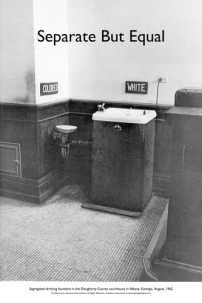 If the statute did not prescribe unequal conditions, then, legally, conditions were not unequal. In reality, of course, this ruling institutionalized segregation in housing and transportation and poor schooling for Blacks and residential privilege for whites.
If the statute did not prescribe unequal conditions, then, legally, conditions were not unequal. In reality, of course, this ruling institutionalized segregation in housing and transportation and poor schooling for Blacks and residential privilege for whites.
During that decade, Southern mobs lynched at least a thousand black men and terrorized the rest of the black population into submission. By the end of the century, the work of disenfranchisement was complete. There were 130,000 blacks registered to vote in Louisiana in 1896; in 1904, there were 1,342. In Virginia that year, the estimated black turnout in the Presidential election was zero. Soon, almost all Southern blacks lost their right to vote and were unable to prevent the establishment of the legal foundation for a public education system that, for the next 65 years, would discriminate against blacks and provide educational access and jobs for whites.
And even after that, white flight and de facto segregation would perpetuate those conditions. A significant contemporary version of this unequal world is the fact that the United States, practically unique among nations, still funds its schools primarily through property taxes, giving wealthy suburbs massive advantages over inner city neighborhoods.
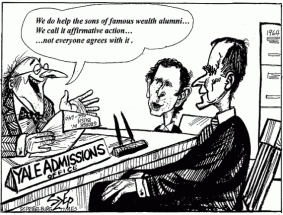 Meanwhile, a private education system modeled on that of Britain’s used legacy admissions to channel the sons of the upper classes, regardless of intelligence, talents or effort, through the prep school system, on to top-level universities and graduate schools and eventually to management positions in industry, politics, finance, diplomacy and espionage.
Meanwhile, a private education system modeled on that of Britain’s used legacy admissions to channel the sons of the upper classes, regardless of intelligence, talents or effort, through the prep school system, on to top-level universities and graduate schools and eventually to management positions in industry, politics, finance, diplomacy and espionage.
1910s: President Woodrow Wilson segregated federal jobs, once again giving whites privileged access to well-paid government work. Throughout these years, every time a person of color (in government or not) was denied a decent-paying job or educational position – and the long-term opportunities they might have provided – a white person almost certainly received it. We have to emphasize this point. Liberals are comfortable acknowledging the history of discrimination. But it takes a further leap of logic to realize something that is patently obvious to people of color. Discrimination is not a single-lane road. Each time a black or brown person is pushed to the back of the line, a white person steps to the front. This is the essence of privilege.
It’s a particularly outrageous irony of American history that, as Michael Kazin writes,
…every major piece of legislation that…Wilson signed to regulate big business—from a major anti-trust act to an eight-hour day for railroad workers—was crafted by a Democrat from one of the states that barred most African Americans from voting.
World War One and the 1920s: We should also acknowledge at this point the vast but unquantifiable loss of equity sustained by every generation of black Americans due to white-on-black race riots, 25 of which occurred during after the “Red Summer” of 1919. The terror continued for several years in places such as Tulsa, Oklahoma, Elaine, Arkansas and Rosewood, Florida.
There can be no more obvious or gruesome example of how very significant numbers of black families that had struggled to acquire property and create middle-class businesses were thrown back in a single day into utter poverty – and how what was left of their assets was confiscated by the state and redistributed to whites. This category would also include property held in common, such as the hundreds of black churches burned down by white racists. All of these events – when they don’t happen to whites or white communities – contribute to the enrichment of whites relative to blacks.
The same situation has persisted in education. Wherever they lived, North or South, throughout the entire twentieth century, black children were channeled into substandard and segregated schools that prepared most of them only for agricultural or domestic work (see below), and later, for the military and the factories. Meanwhile, a minority of white children received educations that gave them the opportunity to rise into the middle class and thus to manage the millions who could not. Indeed, large numbers of whites-only American colleges had been built and serviced for generations by slaves and later by poor blacks. For a more detailed discussion of the intentions of the American education system relative to traditional concepts of initiation, see Chapter Five of my book, or read Dumbing Us Down: The Hidden Curriculum of Compulsory Schooling, by John Taylor Gatto.
Part Three
1930s: Franklin Roosevelt ‘s New Deal prohibited hiring discrimination in the Public Works Administration and the defense industry. And, as the Founding Fathers had done in 1776, it united northern liberals and southern conservatives. However, like them, Roosevelt had to maintain silence on the question of race, fearing that his coalition would disintegrate. Southern politicians, who defeated over 200 anti-lynching bills, supported Social Security only if it excluded agricultural laborers and domestic servants. This compromise deliberately kept some 65% of blacks outside of the protections of the welfare state, including minimum wages. In certain states, that number approached 80%.
In a decade when even large numbers of whites faced starvation, people of color received far less assistance from government than did white people. Far more white farmers than black were able to keep their farms. In addition, Black industrial workers in the North eventually discovered that Social Security itself was unfair, because it used money they contributed to pay benefits disproportionately to whites, who lived longer than most blacks. Ira Katznelson writes, “…each of the old age, social assistance, and unemployment provisions advanced by the Social Security Act was shaped to racist contours.” His book When Affirmative Action Was White is an excellent book-length treatment of this topic. For much of the twentieth century,
The federal government, though seemingly race-neutral, functioned as a commanding instrument of white privilege…The Democratic Party that fashioned and superintended the New Deal and Fair Deal combined two different political systems: one that was incorporating new groups and voters, who had arrived from overseas or had migrated from the South; the other still an authoritarian one-party system, still beholden to racial separation.
Since Southern politicians were privileged to not have to compete in a two-party system, their seniority was exaggerated. They were able to secure a disproportionate number of committee chairmanships that gave them special gatekeeping powers.
They used three mechanisms. First, whenever the nature of the legislation permitted, they sought to leave out as many African Americans as they could…Second, they successfully insisted that the administration of these and other laws, including assistance to the poor and support for veterans, be placed in the hands of local officials who were deeply hostile to black aspirations. Third, they prevented Congress from attaching any sort of anti-discrimination provisions to aide an array of social welfare programs such as community health services, school lunches, and hospital construction grants…
Since blacks were now counted as full citizens in the census, their large presence combined with their frequent inability to vote allowed white citizens to gain representation in higher proportions than their population in the House of Representatives. In the Senate, these seventeen racially segregated states were able to veto any legislation they did not like.
When this power was deployed, as it was in matters of relief and social insurance, it seriously widened the racial gap. Federal social welfare policy operated, in short, not just as an instrument of racial discrimination but as a perverse formula for affirmative action.
Blacks who had migrated northward to escape the repression and take advantage of job prospects often found themselves victimized by the “last hired, first fired” principle. For more, read here.
And they were funneled into segregated housing, caused not only by racist landlords or paranoid communities, but also by redlining practices specifically encouraged by the federal government. The National Housing Act of 1934 established the Federal Housing Administration and the Federal Home Loan Bank Board, which created “residential security maps” for several cities to determine the safety of real estate investments in selected areas. Jamelle Bouie writes:
Existing black neighborhoods were lined as unsafe, and thus ineligible for financing. For prospective property owners, this was terrible: Absent cash on hand, there was no way to afford a home or a business in your area. What’s more, blacks were all but barred from entering white neighborhoods, if not by restrictive racial covenants (which forbid property sales to African Americans and other minorities) then by violence and intimidation. In Chicago, for instance, anti-black riots were a regular part of public life. Here’s Arnold Hirsch, author of Making the Second Ghetto: Race and Housing in Chicago, 1940–1960:
“On July 28, 1957, a crowd of 6,000 to 7,000 whites attacked 100 black picnickers who occupied a portion of the park that had previously been “reserved” for whites. Though blacks had used the park in the past, they were customarily restricted to certain portions of it. More than 500 police were needed to calm the area after two days of disturbances. On the first day alone at least forty-seven persons were injured and sixty to seventy cars stoned. Rioters spilled out of the park, attacked police officers attempting arrests, and, eventually, placed the entire area between the nearby Trumbull Park Homes and Calumet Park in turmoil. Police squadrons had to form a “flying wedge” to break through the crowd to rescue blacks besieged in the park.” In the late 1940s, he writes, there was “one racially motivated bombing or arson” every twenty days.
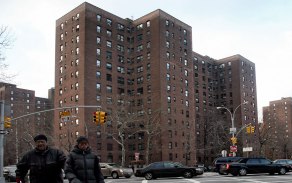 In 1937 the government began to build public housing in 1937, but It was actually designed primarily for working-class white families. Housing built for black people was segregated. In large cities like Chicago and Detroit, public housing became a black program – those horrible concrete high rises that came to be called “the projects” – and the FHA created a different program for whites, which was a single-family suburban program. Terrel Starr writes:
In 1937 the government began to build public housing in 1937, but It was actually designed primarily for working-class white families. Housing built for black people was segregated. In large cities like Chicago and Detroit, public housing became a black program – those horrible concrete high rises that came to be called “the projects” – and the FHA created a different program for whites, which was a single-family suburban program. Terrel Starr writes:
The Federal Housing Administration financed the construction of new single-family homes in suburban developments (and government money plotted and paved the roads to get there). The FHA and the Veteran’s Administration also guaranteed cheap mortgages for the families who moved there, making this new kind of owner-occupied housing often just as affordable as rents had been in public housing projects in the city. Like many of those original projects, though, the new homes were explicitly unavailable to blacks. The FHA required developers to use restrictive covenants barring blacks, and it denied black families the mortgages that allowed working-class whites to leave public housing.
As the white “barely poor” moved out — and as the strict criteria for who could live in public housing faded — the median incomes of the families there began to fall. In 1950, the median household in public housing earned about 57% of the national median income. That number fell to 41% by 1960, then 29% by 1970. By the 1990s, the median family in public housing made only about 17% what the median family in America made.
Relatively speaking, that means public-housing residents by the 1990s were about three times as poor as they had been in the 1950s.
World War Two: Participation in imperial wars is a dubious and difficult moral question. Should we be proud that women can now serve in combat? But it is true that the military – and, eventually, an integrated military – has long offered opportunities for working class Americans to enter the middle class. Kaznelson, however, insists that blacks were inducted at much lower rates than whites, received discriminatory treatment (including health care and training for higher status positions), and served in legally segregated units. He concludes:
…for most African American individuals, and certainly for the group as a whole, war service ended with a wider gap between whites and blacks, as white access to training and occupational advancement moved ahead at a much more vigorous rate.
In America, the fear and uncertainty of wartime always contributes to increased racial tension, and this period was no exception. Just as during the previous war, there were dozens of race riots, almost all of them perpetrated by whites, that primarily destroyed minority lives and property, such as the Zoot Suit riots of 1943.
Post-World War Two: The G.I. Bill created the American middle class, but almost exclusively for whites. First of all, far lower percentages of blacks than whites had been allowed to serve, and thus to qualify for its benefits. Secondly, writes Kaznelson, Southern politicians made sure that “it was deliberately designed to accommodate Jim Crow,” and that it placed nearly impassible boundaries in front of black veterans. Because implementation, including unemployment insurance, loans and funding for college-level education, was left to all-white local officials, “the playing field was never level.” Only one in twelve job training programs in the South admitted blacks, while the white working class received the training that opened further opportunities.
The G.I. Bill financed 90% of the 13 million houses constructed in the 1950s. However, those same Southern politicians made sure that 98% of those homes went to whites, even when home construction was in the North. Of 350,000 federally subsidized homes built in Northern California between 1946 and 1960, fewer than 100 went to blacks, as did none of the 82,000 homes built in Levittown, New York. People of color remained locked in the inner cities, their dwellings and businesses often torn down to make room for the interstates that would shuttle whites to the suburbs where only they could live.
This was the period when Southern Democratic congressman, many of whom had supported New Deal programs that improved labor rights, began to shift their allegiance to anti-union Republicans, eventually reversing the Democratic hold on the South. In the Southwest, Mexicans and Mexican Americans were enduring the effects of the Bracero Program and its aftermath, which I write about here.
When African Americans relocated to friendlier areas, they still had to confront the reality of housing covenants. After the war, it was still common practice for developers and realtors – even in the liberal San Francisco Bay area – to bar non-whites from moving into their newly built homes, and to have such covenants enforced by law. Although they are no longer legally binding, as recently as 2019, researchers found over 20,000 properties in the Seattle area with racial covenants in their deeds.
Part Four
There goes the neighborhood – Old joke (or not).
The 1960s and 1970s: Three-fourths of the one million persons displaced from their homes by the Interstate Highway Program were black. A fifth of all African American housing in the nation was destroyed for highways. The government was reducing the housing stock for blacks at the same time it was expanding it for whites. In fact, since the highway program made “white flight” easier, we can even say that white middle-class housing access – affirmative action – was made possible because of the destruction of housing for African American and Latino communities. Tim Wise writes:
The so-called ghetto was created and not accidentally. It was designed as a virtual holding pen—a concentration camp were we to insist upon honest language—within which impoverished persons of color would be contained. It was created by generations of housing discrimination, which limited where its residents could live. It was created by decade after decade of white riots against black people whenever they would move into white neighborhoods. It was created by deindustrialization and the flight of good-paying manufacturing jobs overseas.
White flight remains a reality to this day, as a recent study points out:
White flight eventually becomes more likely in middle-class neighborhoods when the presence of Hispanics and Asians exceeds 25 percent and 21 percent, respectively…This continuing trend has a number of consequences for an increasingly multicultural America, none of them positive…(as racial segregation has been) a key predictor of reduced life chances, across health, academic, and economic outcomes.
As the federal government finally acknowledged the elephant in the living room – the farcical “separate but equal” – and mandated desegregation in the schools, Southern leaders (soon to be uniformly Republican) faced the fear of race-mixing and solved the dilemma with a stroke of malevolent genius. If they couldn’t prevent black children from entering the best public schools, they could simply transfer their own children to private schools, de-fund the public ones, which were now primarily black and brown, and find ways to subsidize the private ones with public money. The Southern Education Foundation reports:
From the mid-1960s to 1980, as public schools in the Deep South began to slowly desegregate through federal court orders, private school enrollment increased by more than 200,000 students across the region – with about two-thirds of that growth occurring in six states…What was once the South’s 11 percent share of the nation’s private school enrollment had reached 24 percent in 1980…The eleven Southern states of the old Confederacy enrolled between 675,000 and 750,000 white students in the early 1980s, and it is estimated that 65 to 75 percent of these students attended schools in which 90 percent or more of the student body was white.
Northerners have long criticized this situation in the South – and their hypocricy seems to be matched only their apparent ignorance. The anger of working class whites whose wages were stagnating and who perceived that blacks were getting ahead of them would eventually elect con men like Reagan, the Bushes and Trump. But, following the popularity of George Wallace, it erupted in Northern cities such as Boston, which produced one of the most iconic images of the 20th century:
Now, the American school system (especially in Northern cities) is nearly as segregated as it was in 1960, with predictable implications for funding, testing, dropout rates, college placement and job preparation. Eighty percent of Latino students and 74% of black students attend schools that are majority nonwhite. The percentage of black students attending majority white schools has been in decline since 1988, and it is now at its lowest point in almost half a century. In 2003, 1/6 of all black students were educated in “apartheid schools” – schools in which students of color make up 99% of the population The achievement gap between minority and white students continues to widen. Minority high schoolers are performing at academic levels equal to or below those of three decades ago.
1985-present: The War on Drugs has disenfranchised over six million people, two million of whom are black. This simple fact has utterly determined the course of recent history.
Let me say that again: This simple fact has utterly determined the course of history.
The more African Americans a state contains, the more likely it is to ban felons from voting. The average state disenfranchises 2.4% of its voting-age population but 8.4% of blacks. In fourteen states, the share of blacks stripped of the vote exceeds 10%, and in five states it exceeds twenty percent. While 75% of whites register, only 60% of blacks can. In any given Senate, over a dozen Republican senators owe their election to these laws.
Had felons been allowed to vote in 2000, Al Gore’s popular vote margin would have doubled to a million. If Florida had allowed just ex-felons to vote, he still would have carried the state by 30,000 votes and with it the presidency. Would Gore have invaded Iraq and Afghanistan? Would we all have had to endure a bogus war on terror that has cost trillions of dollars and killed several million people? Would the Supreme Court be on the verge of banning abortion? Would the government be leading the world in a race toward a petrochemically induced climate disaster? We can’t answer these questions, but we should continue to ask them.
In 2020 we also have to acknowledge the ongoing voter suppression, gerrymandering and computer fraud in over twenty states, all of which have contributed to Republican control of Congress, the Presidency and the Supreme Court.
And these conditions existed before the Court disemboweled the Voting Rights Act in 2013. After that decision, the 2016 election became the first in fifty years without the full protections of the Voting Rights Act. Again: it’s absolutely certain that without that Court decision, there would be no Trump presidency.
And while we’re at it, let’s take note of another fact: These numbers do not include Americans residing in Puerto Rico, American Samoa, Guam, the Northern Mariana Islands and the U.S. Virgin Islands, all of whom are considered U.S. nationals, who are allowed to vote in primaries (did you know that Michael Bloomberg won his only Democratic delegates in American Samoa’s primary?). But since they are not considered citizens, they cannot vote in general elections. This is an aggregate population of nearly four million people – nearly all of them people of color. Imagine the results if they could vote for President and compare that to the privileges retained by the white supremacist governments from the Carolinas to Arkansas.
Those numbers are dwarfed by an even larger group, those citizens who for all reasons are ineligible to vote, including most prisoners as well as college students on campuses not in their home districts. The adult population is 245 million, and 220 million are eligible to vote (about half of whom actually do). This results in a staggering number: some fifteen to twenty million American adults – at least half of them people of color – are not permitted to vote.
Of course, due to the effort and sacrifices of the Civil Rights movement, most of the older patterns have disappeared, at least legally. But the long-term consequences of 275 years of discrimination remain as a cruel reality. Due to home equity inflation and resulting family inheritance, as well as the exclusion from Social Security and unequal access to capital, an average black family still has one eleventh of the wealth of a white family, even when they make the same income.
As I write in Chapters Six and Ten of my book, a striking aspect of our de-mythologized world is our literalization of the ancient myths of the sacrifice of the children. And one of the prices America pays for its obsession with innocence is the perpetuation of a particularly ironic form of generational cruelty.
It bears repeating that people over 75 years of age, widely celebrated as the “greatest generation,” themselves formerly the recipients of massive government welfare support, are now the demographic most resistant to the extension of those supports to young people and people of color.
Since 1996 nine states have banned affirmative action: California, Texas (subsequently reversed), Washington, Florida, Michigan, Nebraska, Arizona, New Hampshire, and Oklahoma. These bans have led to a 23% drop in the chance of college admission for minority students, compared with a 1% drop in other states, relative to non-minority students.
2008: Long-term patterns of government and private sector discrimination and outright fraud came to a head in the subprime mortgage crisis. During the period preceding the housing boom, 6.2% of whites with good credit scores received high-interest mortgages but 21.4% of blacks with similar scores received these same loans. It turned out that several of the major banks had been purposely giving people of color subprime mortgages, including borrowers who would have qualified for prime loans.
The worst of the lot, Wells Fargo had provided a cash incentive for loan officers to aggressively market subprime mortgages in minority neighborhoods. Women of color were the most likely to receive subprime loans while white men were the least likely.
The results were predictable. Black homeowners were disproportionately affected by the foreclosure crisis, with more than 240,000 blacks losing homes they had owned. Black homeowners in the D.C. region were 20% more likely to lose their homes than whites with similar incomes and lifestyles. From 2005 to 2009, the net worth of black households declined by 53% while the net worth of white households declined by 16%.
Both conscious and unconscious biases remain, leading to findings that job-seekers with black-sounding names are 50% less likely to get a callback than those with white-sounding names, as proof that affirmative action is not obsolete.
In 2020 racial profiling remains a major factor. Police stop and search black and Latino drivers on the basis of less evidence than used in stopping white drivers, who are searched less often even though they are more likely to be found with illegal items. The resultant fines, arrests, legal fees and time spent in court mean that people of color have even less disposable income relative to whites. In New York City alone, the stop-and-frisk program made over 100,000 stops per year between 2003 and 2013, with 686,000 stops at its height in 2011. Ninety percent of those stopped in 2017 were African-American or Latino. Even as recently as 2016, the NYPD made over 12,000 stops.
From the annoying to the most critical: police in the U.S. kill over a thousand people per year. Black males are 2.5 times more likely to be killed by police than whites. For black women, the rate is 1.4 times more likely. It is still true that every 28 hours, an African-American or Latino is shot dead by a police officer, a security guard or a self-appointed vigilante. Eighty percent of the victims are unarmed.
Here is the ultimate in affirmative action for whites: long-term evidence that their lives are worth more to the state than the lives of people of color. “Policing in this country” writes Salim Muwakkil, “has always had the dual purpose of maintaining social order and enforcing the racial hierarchy.” For my thoughts on the massive inequalities in sentencing and prison populations, read here and here.
The final indignity is that most of this vast accumulation of affirmative action for white people is not common knowledge, either in the news media, in politics or at any level of the educational system, including universities. This means that whites have been given free rein to wallow in their ignorance, and thus in their unacknowledged privilege. It means that, most whites have been able to live out their lives completely unaware of the long term, institutional factors that have kept people of color down – and themselves up. James Baldwin’s word said it fifty years ago:
…this is the crime of which I accuse my country and my countrymen and for which neither I nor time nor history will ever forgive them, that they have destroyed and are destroying hundreds of thousands of lives and do not know it and do not want to know it…but it is not permissible that the authors of devastation should also be innocent. It is the innocence which constitutes the crime.
In American theological terms, this means that large numbers of whites are still able to perceive their own relatively happy status as deserved, and the impoverished conditions of millions of black people as their own fault. And when whites feel that they are falling backwards in the rat race, the politicians have provided them with a ready-to-order scapegoat: affirmative action – “discrimination” in favor of those same undeserving, lazy minorities. And the growing realization that whites themselves will be actual minorities (as they are already are in California) soon is a source of terror.
It means that a majority of white people are privileged to believe that they are more often the victims of racism than black people.
Conclusion
Meet the new boss. Same as the old boss – The Who
I first posted this essay in 2015, finishing with these words:
This has been a brief outline of our history of affirmative action for whites. Keep it in mind the next time some fool starts to rant about how minorities get all the breaks. You need to know the facts, and you need to know how they express the myth of American Innocence.
I had already suggested – correctly, I believe – that major power brokers had assigned Barack Obama the task of shoring up holes in the myth of American Innocence. Still, it was a time when I (and probably you) still labored under the misconception that learning the facts about our history and the themes of our mythic narratives would naturally lead people to more progressive politics, and that the power brokers would respond. How naïve I was.
In the spring of 2020 we’ve since had five more years of evidence that logic and reason will not penetrate the hard shell of denial. What I didn’t fully understand when I published my book in 2010 is that the sum total of racist, misogynist, nationalist, materialist, celebrity-worshipping – and for millions, religious – beliefs that fill the regions of the conservative mind compose a solid but extremely fragile identity that has been built up over many generations. Calling any one of its assumptions into question is to open up the possibility that the entire edifice will collapse. We are talking about identity.
The question “Who am I?” is not really meant to get an answer. The question “Who am I?” is meant to dissolve the questioner. – Ramana Maharshi
And now, in the time of plague, in a time when circumstances are offering everyone yet another initiatory moment, it’s clear that the response to the questioning of one’s identity is a terror so deep that most of us will follow any old white con man, one of whom promises to put the sheets back over our eyes, and the other who promises a return to “normalcy.”
And who can blame the Republican faithful for being skeptical about Medicare for all, real tax reform or the dangers of the coronavirus when, as Caitlin Johnstone writes, they’ve been subject to
…mainstream outlets who’ve sold the public lies about war after war, election after election, status quo-supporting narrative after status quo-supporting narrative?
And who can blame the Democratic faithful for absorbing the Russiagate narrative and the “CIA is our friend” narrative and the “defend Israel at all costs” narrative and the “electability” narrative when they’ve been subject for decades to that same media discourse? Looking in from outside the myth of American Innocence, now I can see that the only fundamental difference between reactionaries and conventional liberals is that the first group is angrier and the second is more naïve.
Still, as a mythologist, my work is to offer up historical fact, put it into the context of mythological truth, and use that truth to try to imagine ways to approach a new history of the future. We are better than who we think we are. May this plague finally open our eyes to what true progressives (and now, Bernie Sanders) have been arguing for well over a century – We’re all in this together. May it be so.
Questioner: How should we treat others?
Ramana Maharshi: There are no others.
